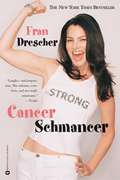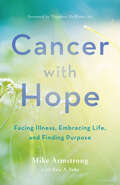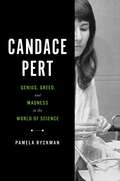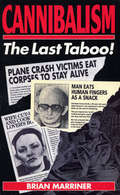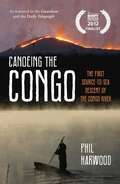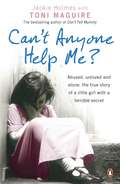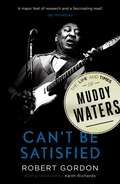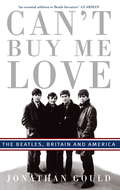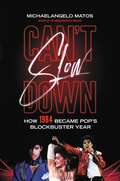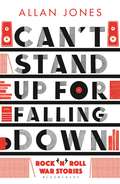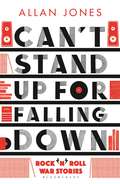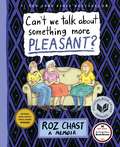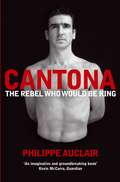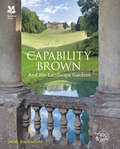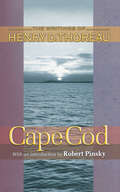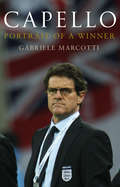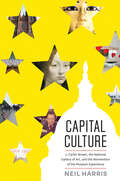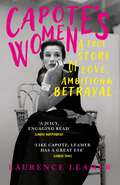- Table View
- List View
Cancer Schmancer (Biography Ser.)
by Fran DrescherWith her trademark humour, Fran tells of her indefatigable search for answers and the cancer diagnosis that she ultimately beat. But not before a goldmine of humorous insights were revealed to her about what really matters most in life.
Cancer with Hope: Facing Illness, Embracing Life, and Finding Purpose
by C. Michael ArmstrongIn Cancer with Hope, former CEO Mike Armstrong chronicles his experience with leukemia, prostate cancer, near-fatal sepsis, and a crippling autoimmune disease. Mike shares how his often difficult journey from humble beginnings to leading some of the world's top corporations taught him the importance of hope and purpose, tools that proved invaluable throughout his cancer journey.More than the tale of one man's experience with cancer, this important book includes expert advice and vetted resources to help patients best manage their disease, as well as compelling stories from a wide range of cancer patients who have faced seemingly insurmountable odds yet managed to maintain hope and find meaningful purpose.
Cancer with Hope: Facing Illness, Embracing Life, and Finding Purpose
by C. Michael ArmstrongIn Cancer with Hope, former CEO Mike Armstrong chronicles his experience with leukemia, prostate cancer, near-fatal sepsis, and a crippling autoimmune disease. Mike shares how his often difficult journey from humble beginnings to leading some of the world's top corporations taught him the importance of hope and purpose, tools that proved invaluable throughout his cancer journey.More than the tale of one man's experience with cancer, this important book includes expert advice and vetted resources to help patients best manage their disease, as well as compelling stories from a wide range of cancer patients who have faced seemingly insurmountable odds yet managed to maintain hope and find meaningful purpose.
Candace Pert: Genius, Greed, and Madness in the World of Science
by Pamela Ryckman"...a truly insightful narrative on what it can mean to be a woman at the cutting edge of science." —THE WALL STREET JOURNALThe story of maverick scientist Candace Pert, whose groundbreaking research and book Molecules of Emotion introduced the world to the mind-body connection, opioid receptors, and peptide T, and her fight for recognition in a toxic healthcare system. Candace Pert stood at the dawn of three revolutions: the women&’s movement, integrative health, and psychopharmacology. A scientific prodigy, she was 30 years ahead of her time, preaching a holistic, interdisciplinary approach to healthcare and medicine long before yoga hit the mainstream and &“wellness&” took root in our vernacular. Her bestselling book Molecules of Emotion made her the mother of the Mind/Body Revolution, launching a paradigm shift in medicine. Deepak Chopra credits her with creating his career, and he said as much in his eulogy at her funeral. Candace began her career as an unbridled maverick. In 1972, as a 26-year-old graduate student at Johns Hopkins, she discovered the opiate receptor, revolutionizing her field and enabling pharmacologists to design new classifications of drugs from Prozac to Viagra to Percocet and OxyContin. The tragic irony of her breakthrough, touted as the first step to end heroin addiction, is that it helped spawn a virulent epidemic of drug dependence. Facing the largest public health crisis of the 21st century, Candace was incensed that the Hippocratic oath—&“first, do no harm&”—would succumb to greed, and as witness to this abuse of power, she was one of few scientists courageous enough to protest. Later, as Chief of Brain Biochemistry at the National Institutes of Health, Candace created Peptide T, the non-toxic treatment for HIV featured in Dallas BuyersClub. As the AIDS pandemic raged, triggering panic across Reagan-era America, the U.S. government poured massive amounts of money into finding a cure, sparking a battle among scientists for funding and power. Bested by rivals with competing drugs yet desperate to help, Candace went rogue, becoming a lynchpin in the black market for Peptide T. After a scandalous departure from her tenured position at the NIH, Candace launched a series of private companies with Michael Ruff, her second husband and collaborator. Naïve to the world of business, she was manipulated by investors keen to wrest control of her discoveries. But Candace too became tainted, believing that her noble ends would justify devious means. Like a mythic hero, she succumbed to a fatal flaw, and her greatest strengths—singularity of purpose and blind faith in her own virtuosity—would prove to be her undoing.
Cannibalism - The Last Taboo: The Last Taboo!
by Brian MarrinerDrawing on historical evidence and recent criminal cases, Marriner's chilling catalogue of human flesh-eaters takes us to the frontiers of real-life horror...
Canoeing the Congo: The First Source-to-Sea Descent of the Congo River
by Phil HarwoodEx-Marine Phil Harwood embarked on an epic solo journey on the Congo, the eighth longest river in the world. He faced swamps, man-eating crocodiles, snakes and spiders’ webs the size of houses. He collapsed from malaria, and was arrested. But he also received tremendous hospitality from proud people long forgotten by the Western world.
Can't Anyone Help Me?
by Toni MaguireAbused, unloved and alone. Can't Anyone Help Me? is the shocking true story by Toni Maguire.Jackie was an unwanted child. So unwanted that her mother regularly left Jackie at her uncle's house. Which was when the nightmare started. For when his wife went out, her uncle's friends came round. He had a Special Room. In it Jackie was tied up and molested, beaten, burnt by cigarettes and urinated on. Sometimes other children were brought along. Jackie got to know the Special Room intimately.Jackie could never bring herself to tell her mother. She ended up in a home for disturbed children. She ran away, and a life of homelessness, drugs, prostitution and psychiatric wards followed. Eventually, Jackie sought help. But could she turn her life around? Would her evil uncle and his Special Room haunt her forever?Can't Anyone Help Me? by Toni Maguire is the inspirational story of struggle and survival against all odds as one young woman attempts to put her torturous past behind her and make a future for herself.Toni Maguire is the author of four bestselling books: Don't Tell Mummy, When Daddy Comes Home,Nobody Came and Helpless.
Can't Be Satisfied: The Life and Times of Muddy Waters
by Robert GordonCan't Be Satisfied is that rare thing in musical biographies: a book that maps out not just a single, extraordinary life but the cultural forces that shaped it' Sean O'Hagan, Observer Muddy Waters was the greatest blues musician ever, and the most influential. He invented electric blues, inspired the Rolling Stones and created the template for the rock 'n' roll band and its wild lifestyle. Robert Gordon's definitive biography vividly chronicles the extraordinary life and personality of the musical legend who changed the course of modern popular music.
Can't Buy Me Love: The Beatles, Britain, and America
by Jonathan GouldJonathan Gould's Can't Buy Me Love is more than just a book on the Beatles; it's a stunning recreation of the 1960s in England and America through the prism of the world's most iconic band. The Beatles, perhaps more than any act before or since, were a quintessential product of their time, and Gould brilliantly blends cultural history, musical analysis and group biography to show the unique part they played in the shaping of post-war Britain and America. Gould examines the influence of R&B, rockabilly, skiffle and Motown as the Fab Four forged a sound of their own; he illuminates the mercurial relationship the most productive and lucrative in recording music history between John Lennon and Paul McCartney; he critiques the songs they played and the movies they made, and their impact on competing bands and musicians, as well as on fashion, hairstyles, and humour; and he shows how events on both sides of the Atlantic created exactly the right cultural climate for the biggest music phenomenon of 20th century. Beautifully written, insightful, and wonderfully evocative, this is a magisterial biography by a popular historian of the very first rank.
Can't Slow Down: How 1984 Became Pop's Blockbuster Year
by Michaelangelo MatosThe definitive account of pop music in the mid-eighties, from Prince and Madonna to the underground hip-hop, indie rock, and club scenesEverybody knows the hits of 1984 - pop music's greatest year. From "Thriller" to "Purple Rain," "Hello" to "Against All Odds," "What's Love Got to Do with It" to "Wake Me Up Before You Go-Go," these iconic songs continue to dominate advertising, karaoke nights, and the soundtracks for film classics (Boogie Nights) and TV hits (Stranger Things). But the story of that thrilling, turbulent time, an era when Top 40 radio was both the leading edge of popular culture and a moral battleground, has never been told with the full detail it deserves - until now. Can't Slow Down is the definitive portrait of the exploding world of mid-eighties pop and the time it defined, from Cold War anxiety to the home-computer revolution. Big acts like Michael Jackson (Thriller), Prince (Purple Rain), Madonna (Like a Virgin), Bruce Springsteen (Born in the U.S.A.), and George Michael (Wham!'s Make It Big) rubbed shoulders with the stars of the fermenting scenes of hip-hop, indie rock, and club music. Rigorously researched, mapping the entire terrain of American pop, with crucial side trips to the UK and Jamaica, from the biz to the stars to the upstarts and beyond, Can't Slow Down is a vivid journey to the very moment when pop was remaking itself, and the culture at large - one hit at a time.
Can't Stand Up For Falling Down: Rock'n'Roll War Stories
by Allan JonesAllan Jones launched Uncut magazine in 1997 and for 15 years wrote a popular monthly column called Stop Me If You've Heard This One Before, based on his experiences as a music journalist in the 70s and 80s, a gilded time for the music press. By turns hilarious, cautionary, poignant and powerful, the Stop Me...stories collected here include encounters with some of rock's most iconic stars, including David Bowie, Lou Reed, Leonard Cohen, Van Morrison, Neil Young, Elvis Costello, The Sex Pistols, The Clash, The Smiths, R.E.M. and Pearl Jam. From backstage brawls and drug blow-outs, to riots, superstar punch-ups, hotel room confessionals and tour bus lunacy, these are stories from the madness of a music scene now long gone.
Can't Stand Up For Falling Down: Rock'n'Roll War Stories
by Allan JonesAllan Jones launched Uncut magazine in 1997 and for 15 years wrote a popular monthly column called Stop Me If You've Heard This One Before, based on his experiences as a music journalist in the 70s and 80s, a gilded time for the music press. By turns hilarious, cautionary, poignant and powerful, the Stop Me...stories collected here include encounters with some of rock's most iconic stars, including David Bowie, Lou Reed, Leonard Cohen, Van Morrison, Neil Young, Elvis Costello, The Sex Pistols, The Clash, The Smiths, R.E.M. and Pearl Jam. From backstage brawls and drug blow-outs, to riots, superstar punch-ups, hotel room confessionals and tour bus lunacy, these are stories from the madness of a music scene now long gone.
Can't We Talk about Something More Pleasant?: A Memoir
by Roz Chast#1 New York Times Bestseller2014 NATIONAL BOOK AWARD FINALISTIn her first memoir, New Yorker cartoonist Roz Chast brings her signature wit to the topic of aging parents. Spanning the last several years of their lives and told through four-color cartoons, family photos, and documents, and a narrative as rife with laughs as it is with tears, Chast's memoir is both comfort and comic relief for anyone experiencing the life-altering loss of elderly parents.When it came to her elderly mother and father, Roz held to the practices of denial, avoidance, and distraction. But when Elizabeth Chast climbed a ladder to locate an old souvenir from the “crazy closet”-with predictable results-the tools that had served Roz well through her parents' seventies, eighties, and into their early nineties could no longer be deployed. While the particulars are Chast-ian in their idiosyncrasies-an anxious father who had relied heavily on his wife for stability as he slipped into dementia and a former assistant principal mother whose overbearing personality had sidelined Roz for decades-the themes are universal: adult children accepting a parental role; aging and unstable parents leaving a family home for an institution; dealing with uncomfortable physical intimacies; managing logistics; and hiring strangers to provide the most personal care. An amazing portrait of two lives at their end and an only child coping as best she can, Can't We Talk about Something More Pleasant will show the full range of Roz Chast's talent as cartoonist and storyteller.
Cantona: The Rebel Who Would Be King
by Philippe Auclair'An artist, in my eyes, is someone who can lighten up a dark room. I have never and will never find difference between the pass from Pele to Carlos Alberto in the final of the World Cup in 1970, and the poetry of the young Rimbaud' - Eric Cantona Football, and art. Eric Cantona – legend, maverick, troubled artist or just plain trouble – never saw a need to make a distinction between the two. For all the heat and noise surrounding his infamous Crystal Palace 'kung-fu kick', it is for the sheer exuberant beauty of his play that Eric Cantona is chiefly remembered by English football fans. At Leeds United he transformed the team into title contenders, but became a true talisman at Manchester United, where to this day fans sing of 'King Eric'. And yet the effortless style of Cantona's play could not hide a darker side to his temperament. In his own words, 'I play with passion and fire. I have to accept that sometimes, this fire does harm.'In Cantona: The Rebel Who Would Be King leading French football journlist Philippe Auclair has interviewed over 200 key protagonists in Cantona's career, searching for the man behind the myth. Marrying a deep knowledge of Cantona's impact on the pitch with soulful, pin-sharp insight into the heart and inner thoughts of this most complex of characters, this is nothing less than the definitive biography of a one-time rebel of the French game, who rose to be the King of Old Trafford. 'I'd give all the champagne I've ever drunk to be playing alongside Cantona in a big European match at Old Trafford' - George Best
Capability Brown: And His Landscape Gardens (National Trust History And Heritage Ser.)
by Sarah RutherfordOne of the most remarkable men of the 18th century, Lancelot ‘Capability’ Brown was known to many as ‘The Omnipotent Magician’ who could transform unpromising countryside into beautiful parks that seemed to be only the work of nature.
Cape Cod
by Henry David Thoreau Joseph J. Moldenhauer Robert PinskyThis new paperback edition of Henry D. Thoreau's compelling account of Cape Cod contains the complete, definitive text of the original. Introduced by American poet and literary critic Robert Pinsky--himself a resident of Cape Cod--this volume contains some of Thoreau's most beautiful writings. In the plants, animals, topography, weather, and people of Cape Cod, Thoreau finds "another world" Encounters with the ocean dominate this book, from the fatal shipwreck of the opening chapter to his later reflections on the Pilgrims' landing and reconnaissance. Along the way, Thoreau relates the experiences of fishermen and oystermen, farmers and salvagers, lighthouse-keepers and ship captains, as well as his own intense confrontations with the sea as he travels the land's outermost margins. Chronicles of exploration, settlement, and survival on the Cape lead Thoreau to reconceive the history of New England--and to recognize the parochialism of history itself.
Cape Cod (PDF)
by Henry David Thoreau Joseph J. Moldenhauer Robert PinskyThis new paperback edition of Henry D. Thoreau's compelling account of Cape Cod contains the complete, definitive text of the original. Introduced by American poet and literary critic Robert Pinsky--himself a resident of Cape Cod--this volume contains some of Thoreau's most beautiful writings. In the plants, animals, topography, weather, and people of Cape Cod, Thoreau finds "another world" Encounters with the ocean dominate this book, from the fatal shipwreck of the opening chapter to his later reflections on the Pilgrims' landing and reconnaissance. Along the way, Thoreau relates the experiences of fishermen and oystermen, farmers and salvagers, lighthouse-keepers and ship captains, as well as his own intense confrontations with the sea as he travels the land's outermost margins. Chronicles of exploration, settlement, and survival on the Cape lead Thoreau to reconceive the history of New England--and to recognize the parochialism of history itself.
Capello: Portrait Of A Winner
by Gabriele MarcottiFabio Capello is a born winner. As a midfielder with Roma, Juventus and Milan, he won four Italian league championships and two cups, and played for his country 32 times, scoring a goal at Wembley in 1973 in Italy's first ever win in England. As a manager, Capello's fierce determination has seen him win championships with every club he has taken charge of, from Milan in the early 1990s to Real Madrid with David Beckham in 2007.Now he faces his greatest challenge yet: to restore England to the top of world football and take them to the World Cup in South Africa in 2010 - and win. For Capello, nothing less than the best will do.In Capello: Portrait of a Winner, award-winning writer Gabriele Marcotti travels from Capello's early days in Italy to the first months in his new job to tell the story of the man behind the steely glare. Capello has made more than a few enemies over the years, and Marcotti has talked to them all, as well as his closest associates. No-one has ever got this close to Capello before, and this is the story not just of a remarkable career, but of the life of a truly extraordinary man.
Capital Culture: J. Carter Brown, the National Gallery of Art, and the Reinvention of the Museum Experience
by Neil HarrisAmerican art museums flourished in the late twentieth century, and the impresario leading much of this growth was J. Carter Brown, director of the National Gallery of Art in Washington, DC, from 1969 to 1992. Along with S. Dillon Ripley, who served as Smithsonian secretary for much of this time, Brown reinvented the museum experience in ways that had important consequences for the cultural life of Washington and its visitors as well as for American museums in general. In Capital Culture, distinguished historian Neil Harris provides a wide-ranging look at Brown’s achievement and the growth of museum culture during this crucial period. Harris combines his in-depth knowledge of American history and culture with extensive archival research, and he has interviewed dozens of key players to reveal how Brown’s showmanship transformed the National Gallery. At the time of the Cold War, Washington itself was growing into a global destination, with Brown as its devoted booster. Harris describes Brown’s major role in the birth of blockbuster exhibitions, such as the King Tut show of the late 1970s and the National Gallery’s immensely successful Treasure Houses of Britain, which helped inspire similarly popular exhibitions around the country. He recounts Brown’s role in creating the award-winning East Building by architect I. M. Pei and the subsequent renovation of the West building. Harris also explores the politics of exhibition planning, describing Brown's courtship of corporate leaders, politicians, and international dignitaries. In this monumental book Harris brings to life this dynamic era and exposes the creation of Brown's impressive but costly legacy, one that changed the face of American museums forever.
Capital Culture: J. Carter Brown, the National Gallery of Art, and the Reinvention of the Museum Experience
by Neil HarrisAmerican art museums flourished in the late twentieth century, and the impresario leading much of this growth was J. Carter Brown, director of the National Gallery of Art in Washington, DC, from 1969 to 1992. Along with S. Dillon Ripley, who served as Smithsonian secretary for much of this time, Brown reinvented the museum experience in ways that had important consequences for the cultural life of Washington and its visitors as well as for American museums in general. In Capital Culture, distinguished historian Neil Harris provides a wide-ranging look at Brown’s achievement and the growth of museum culture during this crucial period. Harris combines his in-depth knowledge of American history and culture with extensive archival research, and he has interviewed dozens of key players to reveal how Brown’s showmanship transformed the National Gallery. At the time of the Cold War, Washington itself was growing into a global destination, with Brown as its devoted booster. Harris describes Brown’s major role in the birth of blockbuster exhibitions, such as the King Tut show of the late 1970s and the National Gallery’s immensely successful Treasure Houses of Britain, which helped inspire similarly popular exhibitions around the country. He recounts Brown’s role in creating the award-winning East Building by architect I. M. Pei and the subsequent renovation of the West building. Harris also explores the politics of exhibition planning, describing Brown's courtship of corporate leaders, politicians, and international dignitaries. In this monumental book Harris brings to life this dynamic era and exposes the creation of Brown's impressive but costly legacy, one that changed the face of American museums forever.
Capital Culture: J. Carter Brown, the National Gallery of Art, and the Reinvention of the Museum Experience
by Neil HarrisAmerican art museums flourished in the late twentieth century, and the impresario leading much of this growth was J. Carter Brown, director of the National Gallery of Art in Washington, DC, from 1969 to 1992. Along with S. Dillon Ripley, who served as Smithsonian secretary for much of this time, Brown reinvented the museum experience in ways that had important consequences for the cultural life of Washington and its visitors as well as for American museums in general. In Capital Culture, distinguished historian Neil Harris provides a wide-ranging look at Brown’s achievement and the growth of museum culture during this crucial period. Harris combines his in-depth knowledge of American history and culture with extensive archival research, and he has interviewed dozens of key players to reveal how Brown’s showmanship transformed the National Gallery. At the time of the Cold War, Washington itself was growing into a global destination, with Brown as its devoted booster. Harris describes Brown’s major role in the birth of blockbuster exhibitions, such as the King Tut show of the late 1970s and the National Gallery’s immensely successful Treasure Houses of Britain, which helped inspire similarly popular exhibitions around the country. He recounts Brown’s role in creating the award-winning East Building by architect I. M. Pei and the subsequent renovation of the West building. Harris also explores the politics of exhibition planning, describing Brown's courtship of corporate leaders, politicians, and international dignitaries. In this monumental book Harris brings to life this dynamic era and exposes the creation of Brown's impressive but costly legacy, one that changed the face of American museums forever.
Capital Culture: J. Carter Brown, the National Gallery of Art, and the Reinvention of the Museum Experience
by Neil HarrisAmerican art museums flourished in the late twentieth century, and the impresario leading much of this growth was J. Carter Brown, director of the National Gallery of Art in Washington, DC, from 1969 to 1992. Along with S. Dillon Ripley, who served as Smithsonian secretary for much of this time, Brown reinvented the museum experience in ways that had important consequences for the cultural life of Washington and its visitors as well as for American museums in general. In Capital Culture, distinguished historian Neil Harris provides a wide-ranging look at Brown’s achievement and the growth of museum culture during this crucial period. Harris combines his in-depth knowledge of American history and culture with extensive archival research, and he has interviewed dozens of key players to reveal how Brown’s showmanship transformed the National Gallery. At the time of the Cold War, Washington itself was growing into a global destination, with Brown as its devoted booster. Harris describes Brown’s major role in the birth of blockbuster exhibitions, such as the King Tut show of the late 1970s and the National Gallery’s immensely successful Treasure Houses of Britain, which helped inspire similarly popular exhibitions around the country. He recounts Brown’s role in creating the award-winning East Building by architect I. M. Pei and the subsequent renovation of the West building. Harris also explores the politics of exhibition planning, describing Brown's courtship of corporate leaders, politicians, and international dignitaries. In this monumental book Harris brings to life this dynamic era and exposes the creation of Brown's impressive but costly legacy, one that changed the face of American museums forever.
Capital Culture: J. Carter Brown, the National Gallery of Art, and the Reinvention of the Museum Experience
by Neil HarrisAmerican art museums flourished in the late twentieth century, and the impresario leading much of this growth was J. Carter Brown, director of the National Gallery of Art in Washington, DC, from 1969 to 1992. Along with S. Dillon Ripley, who served as Smithsonian secretary for much of this time, Brown reinvented the museum experience in ways that had important consequences for the cultural life of Washington and its visitors as well as for American museums in general. In Capital Culture, distinguished historian Neil Harris provides a wide-ranging look at Brown’s achievement and the growth of museum culture during this crucial period. Harris combines his in-depth knowledge of American history and culture with extensive archival research, and he has interviewed dozens of key players to reveal how Brown’s showmanship transformed the National Gallery. At the time of the Cold War, Washington itself was growing into a global destination, with Brown as its devoted booster. Harris describes Brown’s major role in the birth of blockbuster exhibitions, such as the King Tut show of the late 1970s and the National Gallery’s immensely successful Treasure Houses of Britain, which helped inspire similarly popular exhibitions around the country. He recounts Brown’s role in creating the award-winning East Building by architect I. M. Pei and the subsequent renovation of the West building. Harris also explores the politics of exhibition planning, describing Brown's courtship of corporate leaders, politicians, and international dignitaries. In this monumental book Harris brings to life this dynamic era and exposes the creation of Brown's impressive but costly legacy, one that changed the face of American museums forever.
Capital Culture: J. Carter Brown, the National Gallery of Art, and the Reinvention of the Museum Experience
by Neil HarrisAmerican art museums flourished in the late twentieth century, and the impresario leading much of this growth was J. Carter Brown, director of the National Gallery of Art in Washington, DC, from 1969 to 1992. Along with S. Dillon Ripley, who served as Smithsonian secretary for much of this time, Brown reinvented the museum experience in ways that had important consequences for the cultural life of Washington and its visitors as well as for American museums in general. In Capital Culture, distinguished historian Neil Harris provides a wide-ranging look at Brown’s achievement and the growth of museum culture during this crucial period. Harris combines his in-depth knowledge of American history and culture with extensive archival research, and he has interviewed dozens of key players to reveal how Brown’s showmanship transformed the National Gallery. At the time of the Cold War, Washington itself was growing into a global destination, with Brown as its devoted booster. Harris describes Brown’s major role in the birth of blockbuster exhibitions, such as the King Tut show of the late 1970s and the National Gallery’s immensely successful Treasure Houses of Britain, which helped inspire similarly popular exhibitions around the country. He recounts Brown’s role in creating the award-winning East Building by architect I. M. Pei and the subsequent renovation of the West building. Harris also explores the politics of exhibition planning, describing Brown's courtship of corporate leaders, politicians, and international dignitaries. In this monumental book Harris brings to life this dynamic era and exposes the creation of Brown's impressive but costly legacy, one that changed the face of American museums forever.
Capote's Women: A True Story of Love, Ambition and Betrayal
by Laurence Leamer'There are certain women,' Truman Capote wrote, 'who, though perhaps not born rich, are born to be rich.'These women captivated and enchanted Capote - he befriended them, received their deepest confidences, and ingratiated himself into their lives. From Barbara 'Babe' Paley to Lee Radziwill (Jackie Kennedy's sister) they were the toast of mid-century New York, each beautiful and distinguished in her own way.For years, Capote had been trying to write what he believed would be his magnum opus, Answered Prayers. But when he eventually published a few chapters in Esquire, the barely fictionalised lives (and scandals) of his closest female confidantes were laid bare for all to see. The blowback incinerated his relationships and banished Capote from their high-society world forever.In Capote's Women, New York Times bestselling author Laurence Leamer investigates the true story of the renowned author and his famous friends, weaving a fascinating tale of friendship, intrigue, and betrayal.
